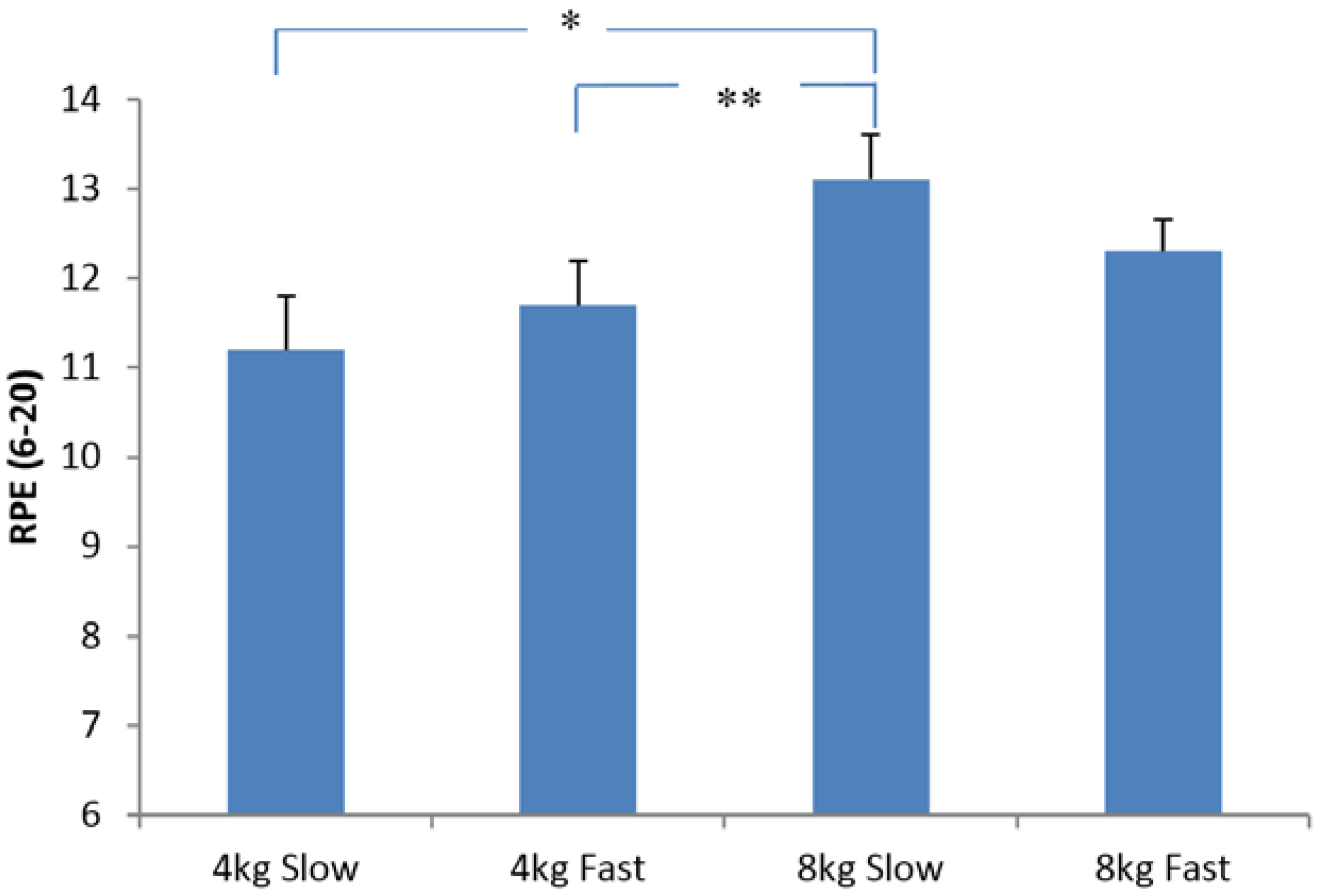The Effect of Kettlebell Swing Load and Cadence on Physiological, Perceptual and Mechanical Variables
Abstract
:1. Introduction
2. Method, Results, Discussion
2.1. Method
2.1.1. Participants
2.1.2. Procedures
2.1.3. Statistical Analysis
2.2. Results
2.3. Discussion

| 4 kg Slow | 4 kg Fast | 8 kg Slow | 8 kg Fast | |||||
|---|---|---|---|---|---|---|---|---|
| Mid Point | End Point | Mid Point | End Point | Mid Point | End Point | Mid Point | End Point | |
| HR (BPM) | 144 (4.8) | 151 (4.4) | 148 (3.9) | 155 (3.7) | 148 (7.1) | 160 (4.3) | 150 (3.7) | 155 (4.2) |
| Bla (mmol/L) | - | 5.8 (1.1) | - | 4.9 (.55) | - | 7.5 (1.6) | - | 5.8 (1.1) |
| Peak Force (N) | 562.5 (67.0) | 551.2 (63.1) | 516.2 (126.3) | 462.9 (136.8) | 623.1 (60.1) | 585.4 (56.3) | 557.6 (112.2) | 539.3 (112.1) |
3. Conclusion
Author Contributions
Conflicts of Interest
References
- Tsatsouline, P. Enter the Kettlebell; Dragon Door Publications: St. Paul, MN, USA, 2006. [Google Scholar]
- O’Hara, R.B.; Serres, J.; Traver, K.L.; Wright, B.; Vojta, C.; Eveland, E. The influence of non-traditional training modalities in physical performance: Review of the Literature. Aviat Space Environ. Med. 2012, 83, 985–990. [Google Scholar] [CrossRef] [PubMed]
- Brumitt, J.; En Gilpin, H.; Brunette, M.; Meira, E.P. Incorporating kettlebells into a lower extremity sports rehabilitation program. North Am. J. Sports Phys. Ther. 2010, 5, 257–265. [Google Scholar]
- Zebis, M.K.; Skotte, J.; Andersen, C.H.; Mortensen, P.; Petersen, M.H.; Viskaer, T.C.; Jensen, T.L.; Bencke, J.; Andersen, L.L. Kettlebell swing targets semitendinosus and supine leg curl targets biceps femoris: An EMG study with rehabilitation implications. Br. J. Sports Med. 2013, 47, 1192–1198. [Google Scholar] [CrossRef] [PubMed]
- Jay, K.; Frisch, D.; Hansen, K.; Zebis, M.K.; Andersen, C.H.; Mortensen, O.S.; Andersen, L.L. Kettlebell training for musculoskeletal and cardiovascular health: A randomized controlled trial. Scand. J. Work Environ. Health 2011, 37, 196–203. [Google Scholar] [CrossRef] [PubMed]
- Farrar, R.E.; Mayhew, J.L.; Koch, A.J. Oxygen cost of kettlebell swings. J. Strength Cond. Res. 2010, 24, 1034–1036. [Google Scholar] [CrossRef] [PubMed]
- Thomas, J.F.; Larson, K.L.; Hollander, D.B.; Kraemer, R.R. Comparison of two-hand kettlebell exercise and graded treadmill walking: Effectiveness as a stimulus for cardiorespiratory fitness. J. Strength Cond. Res. 2014, 28, 998–1006. [Google Scholar] [CrossRef] [PubMed]
- Lake, J.P.; Lauder, M.A. Mechanical demands of kettlebell swing exercise. J. Strength Cond. Res. 2012, 26, 3209–3216. [Google Scholar] [CrossRef] [PubMed]
- McGill, S.M.; Marshall, L.W. Kettlebell swing, snatch, and bottoms-up carry: Back and hip muscle activation, motion, and low back loads. J. Strength Cond. Res. 2012, 26, 16–27. [Google Scholar] [CrossRef] [PubMed]
- Husley, C.R.; Soto, D.T.; Koch, A.J.; Mayhew, J.L. Comparison of kettlebell swings and treadmill running at equivalent RPE Values. J. Strength Cond. Res. 2012, 26, 1203–1207. [Google Scholar] [CrossRef]
- Beardsley, C.; Contreras, B. The role of kettlebells in strength and conditioning: A review of the Literature. Strength Cond. J. 2014, 36, 64–70. [Google Scholar] [CrossRef]
- Borg, G. Perceived exertion as an indicator of somatic stress. Scand. J. Rehab. Med. 1970, 2, 92–98. [Google Scholar]
© 2015 by the authors; licensee MDPI, Basel, Switzerland. This article is an open access article distributed under the terms and conditions of the Creative Commons Attribution license (http://creativecommons.org/licenses/by/4.0/).
Share and Cite
Duncan, M.J.; Gibbard, R.; Raymond, L.M.; Mundy, P. The Effect of Kettlebell Swing Load and Cadence on Physiological, Perceptual and Mechanical Variables. Sports 2015, 3, 202-208. https://doi.org/10.3390/sports3030202
Duncan MJ, Gibbard R, Raymond LM, Mundy P. The Effect of Kettlebell Swing Load and Cadence on Physiological, Perceptual and Mechanical Variables. Sports. 2015; 3(3):202-208. https://doi.org/10.3390/sports3030202
Chicago/Turabian StyleDuncan, Michael J., Rosanna Gibbard, Leanne M. Raymond, and Peter Mundy. 2015. "The Effect of Kettlebell Swing Load and Cadence on Physiological, Perceptual and Mechanical Variables" Sports 3, no. 3: 202-208. https://doi.org/10.3390/sports3030202





